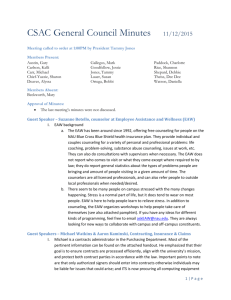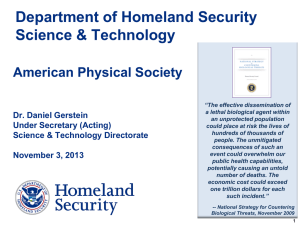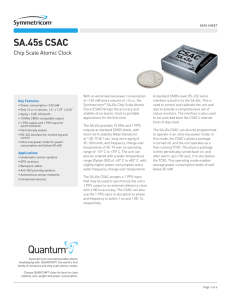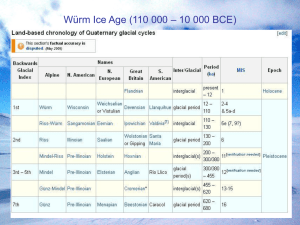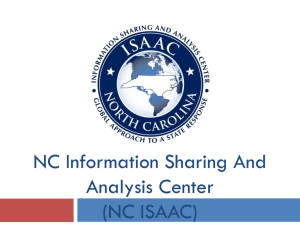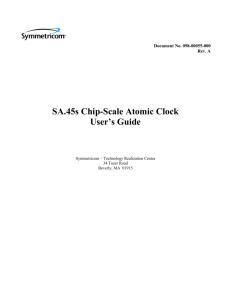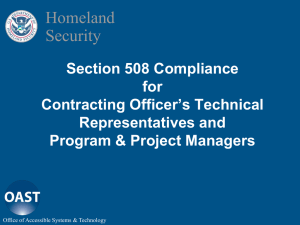DHS presentation to NMTC 140911
advertisement
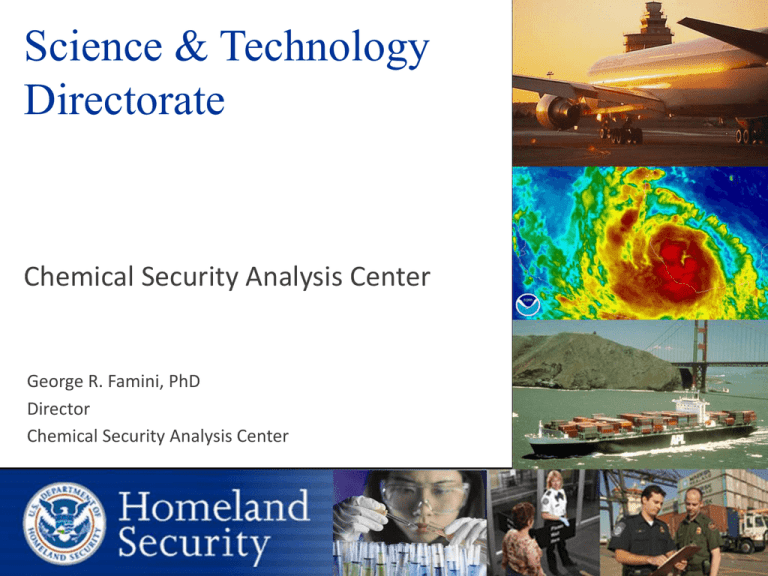
Science & Technology Directorate Chemical Security Analysis Center George R. Famini, PhD Director Chemical Security Analysis Center Department of Homeland Security 621 E. Pratt Street, Suite 210 Homeland Security Missions Preventing Terrorism and Enhancing Security Securing and Managing our Borders Enforcing and Administering our Immigration Laws Safeguarding and Securing Cyberspace Ensuring Resilience to Disasters Strengthening the Homeland Security Enterprise DHS S&T Mission Strengthen America’s security and resiliency by providing knowledge products and innovative technology solutions for the Homeland Security Enterprise Achieving the S&T Mission in a Challenging Environment S&T Strategic Goals – Rapidly develop and deliver knowledge, analyses and innovative solutions that advance the mission of the Department. – Leverage technical expertise to assist DHS components’ efforts to establish operational requirements and select and acquire needed technologies. – Strengthen the Homeland Security Enterprise and First Responders’ capabilities to protect the homeland and respond to disasters. – Conduct, catalyze and survey scientific discoveries and inventions relevant to existing and emerging homeland security challenges. – Foster a culture of innovation and learning, in S&T and across DHS, that addresses the challenges with scientific, analytic and technical rigor. 5 S&T’s Value Added Proposition How S&T Supports the Homeland Security Enterprise REQUIREMENTS DEVELOPMENT Mission Needs Analysis STUDIES & ANALYSIS Analysis of Alternatives (AOA) Operational Requirements Development Consulting on capabilities, technology and processes Key Performance Parameters CONOPS Development Technology Foraging Technology Foraging RESEARCH & DEVELOPMENT R&D & Applied) (Basic Prototyping Concept Development Test & Evaluation Technology Foraging ACQUISITION LIFECYCLE Systems Engineering Lifecycle Support Acquisition & Commercialization Support Consulting Contracting Strategies Program Management Logistics Planning Knowledge Management & Process Improvement Formal Acquisition Test & Evaluation Transition Support Partnership between S&T and Components 6 Science and Technology Research &Development Partnerships 3 of S&T’s Laboratories Operate out of the Office of National Labs Science and Technology (S&T) Laboratories National Biodefense Analysis and Countermeasures Center (NBACC) • Ft Detrick, MD • Bioterrorism Threats Plum Island Animal Disease Center (PIADC) * • Off Long Island • Animal Diseases Transportation Security Laboratory (TSL) • Atlantic City, NJ • Improvised Explosive Threats National Urban Security Technology Laboratory (NUSTL) • NY, NY • Nuclear Detection, First Responders * PIADC to be replaced by National Bio and Agro Defense Facility (NBAF) in Manhattan, KS Chemical Security Analysis Center (CSAC) • Aberdeen, MD • Chemical Threats 9 CSAC - Lab at a Glance Chemical Security Analysis Center (CSAC) Plum Island Animal Disease Center (PIADC) Transportation Security Laboratory (TSL) National Biodefense Analysis and Countermeasures Center (NBACC) National Urban Security Technology Laboratory (NUSTL) Chemical Security Analysis Center, Aberdeen Proving Ground – Edgewood Area (APG-EA), Edgewood, MD • Established in 2006, CSAC is one of five DHS/S&T Laboratories • Focus is on understanding and mitigating toxic chemical threats and hazardous chemical processes • Edgewood, MD location leverages Army expertise in the areas of chemical defense, chemical threat agents, and toxic industrial chemicals • 2nd MOA signed in May, 2011 reinforces the cooperative relationship between DHS/S&T’s CSAC and DoD Co-Located with DoD for improved capability and ROI 10 CSAC Project Overview Goal: To provide an enduring capability to identify and characterize the chemical threat against the American homeland and American public. Approach Focus on information related to chemical threats Integration and analysis of chemical threat information and data Reachback capability to provide expert analysis support Fusion of information from different communities Coordinate all activities with stakeholders/customers Only Homeland Security Enterprise activity whose primary focus is Data and information collection and collation (Library) Threat and Risk Analysis Significant leveraging occurring with intraDHS and interagency stakeholders Intelligence Community Basic Science CSAC Operational Requirements Chemical Industry This project provides the base funding for the CSAC to be a “one stop shop” for Chemical Threat related information for the Interagency. CSAC-11 CSAC Major Tasks • • Provides an enduring capability for chemical threat awareness and knowledge management Capability is heavily utilized within DHS and the Homeland Security Enterprise 12 This Project provides the core funding for the CSAC activities CSAC’s Priorities in FY14 Jack Rabbit Field Tests S&T Based Reachback Chemical Terrorism Risk Assessment 13 Non-Traditional Agents 6 Chemical Defense Collaboration at APG – Edgewood Area Joint Program Executive Office for Chemical and Biological Defense (JPEO-CBD) Edgewood Chemical Biological Center (ECBC) • • • • 14 Medical Research Institute for Chemical Defense (MRICD) Facilities Personnel Reports and Analysis Joint Projects Contracting Vehicles Subject Matter Expertise Public Health Command (PHC) Chemical Security Analysis Center (CSAC) MOU with DoD in place since 2006 9 DoD personnel detailed to CSAC Use of DoD contracts and contracting Proving Ground – Edgewood Area (APG-EA), Edgewood, MD Access to DoD libraries andAberdeen reports CSAC Project Objectives • • • Primary Objective: Provide relevant information and analyses to the homeland security enterprise To do so, this project must – Maintain a series of complex report, information and data libraries that are fully searchable, current, and accessible to the HSE – Conduct relevant analyses pertaining to the chemical threat, both relative to specific chemicals, and methodologies for the employment of those chemicals – Identify gaps in our knowledge regarding hazardous chemicals – Fill those identified, high priority data gaps Major Deliverables – Full text searchable Chemical Threat library (FY14) – NTA Library (FY14, FY15, FY16) – Chemical Terrorism Risk Assessment Desktop Tool Suite v2.0 (FY14) – Jack Rabbit II demonstration (2, FY15, FY16) – Chemical Terrorism Risk Assessment (FY16) – Computational Toxicology demonstration (FY15-16)

